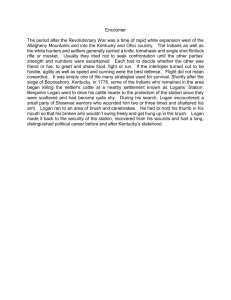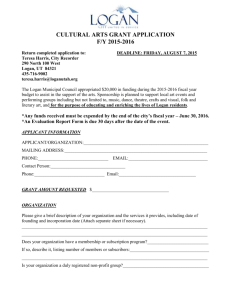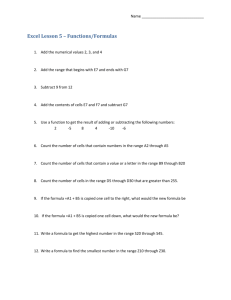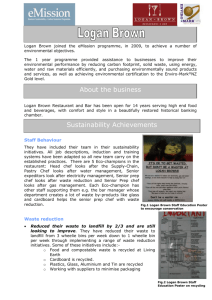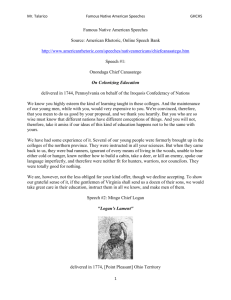Rich in History - Military
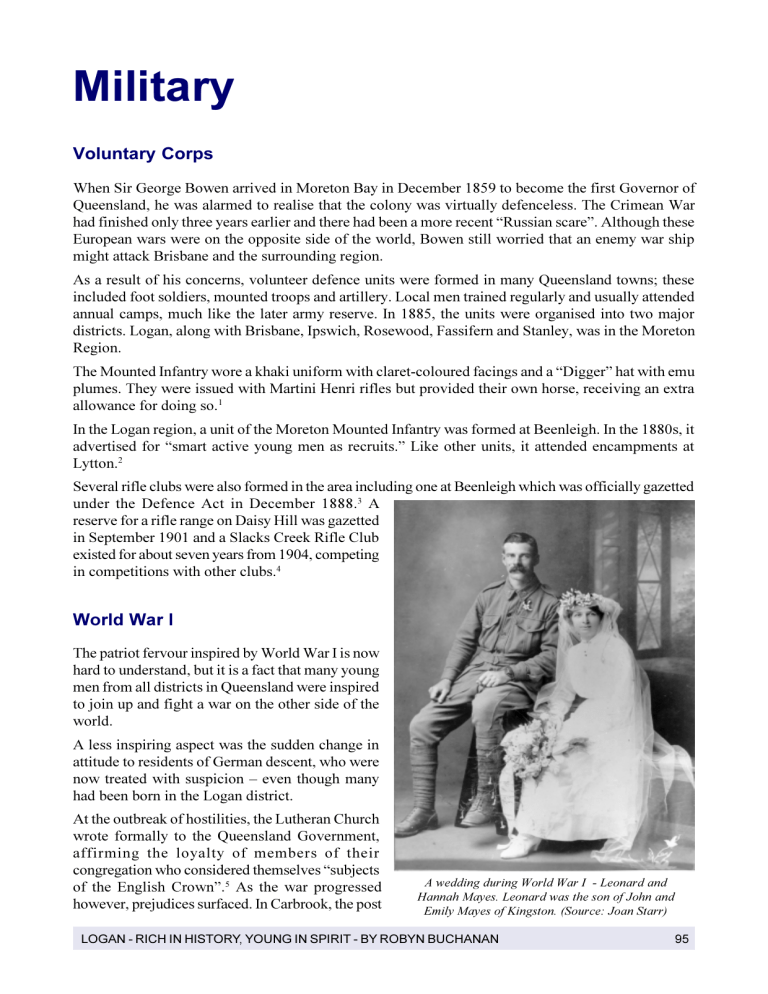
Military
Voluntary Corps
When Sir George Bowen arrived in Moreton Bay in December 1859 to become the first Governor of
Queensland, he was alarmed to realise that the colony was virtually defenceless. The Crimean War had finished only three years earlier and there had been a more recent Russian scare. Although these
European wars were on the opposite side of the world, Bowen still worried that an enemy war ship might attack Brisbane and the surrounding region.
As a result of his concerns, volunteer defence units were formed in many Queensland towns; these included foot soldiers, mounted troops and artillery. Local men trained regularly and usually attended annual camps, much like the later army reserve. In 1885, the units were organised into two major districts. Logan, along with Brisbane, Ipswich, Rosewood, Fassifern and Stanley, was in the Moreton
Region.
The Mounted Infantry wore a khaki uniform with claret-coloured facings and a Digger hat with emu plumes. They were issued with Martini Henri rifles but provided their own horse, receiving an extra allowance for doing so.
1
In the Logan region, a unit of the Moreton Mounted Infantry was formed at Beenleigh. In the 1880s, it advertised for smart active young men as recruits. Like other units, it attended encampments at
Lytton.
2
Several rifle clubs were also formed in the area including one at Beenleigh which was officially gazetted under the Defence Act in December 1888.
3 A reserve for a rifle range on Daisy Hill was gazetted in September 1901 and a Slacks Creek Rifle Club existed for about seven years from 1904, competing in competitions with other clubs.
4
World War I
The patriot fervour inspired by World War I is now hard to understand, but it is a fact that many young men from all districts in Queensland were inspired to join up and fight a war on the other side of the world.
A less inspiring aspect was the sudden change in attitude to residents of German descent, who were now treated with suspicion even though many had been born in the Logan district.
At the outbreak of hostilities, the Lutheran Church wrote formally to the Queensland Government, affirming the loyalty of members of their congregation who considered themselves subjects of the English Crown.
5 As the war progressed however, prejudices surfaced. In Carbrook, the post
A wedding during World War I - Leonard and
Hannah Mayes. Leonard was the son of John and
Emily Mayes of Kingston. (Source: Joan Starr)
LOGAN - RICH IN HISTORY, YOUNG IN SPIRIT - BY ROBYN BUCHANAN 95
office was taken away from the Stern family because Augustus Stern, although Queensland born was of German descent, and was given to a resident of non-German descent.
This was not a Logan phenomenon, as similar incidents were occurring all over Queensland in
Boonah, residents held an indignation meeting when a German boy was employed in the local post office instead of a British boy.
6
In 1915, even places with German-sounding names were targetted. Gramzow became Carbrook, just as in the Ipswich region, Marburg temporarily became Townshend and Minden became Frenchton, while the peaceful Kirchheim (Home of Churches) was permanently renamed Haigslea after General
Haig.
World War II Airfields
During World War II, Archerfield was the major operational aerodrome in the Brisbane area south of the Brisbane River.
Additional smaller airfields were needed for emergency landings and for training new aircrew. Some aircraft were also dispersed to these secondary strips if all the aircraft were concentrated at one major airfield such as Archerfield, an enemy air raid was likely to cause heavy damage. These smaller strips were rudimentary, usually a gravelled surface over which the grass had been allowed to regrow.
In 1940, the RAAF surveyed a number of sites in the Kingston/Woodridge area and selected several possibilities, delaying development because they were all less than ideal.
7
After Japan entered the war, however,
American airforce personnel began to arrive in Australia and training strips were urgently needed. The Americans reviewed the sites already identified and partly developed three.
Kingston A-10 stretched north-west from
Browns Plains Road. A-11 ran parallel with
Wembley Road behind the present-day civic complex and A-12 was further south.
The USA soon lost interest in these strips because they were too steep. A-11 was believed to have some value for emergency landings but all three were basically
Two World War II airfields show up clearly in this 1944 aerial photo. The upper strip A-11 was behind the present-day Council Administration building, parallel with Wembley Rd.. (Source: Dept Natural Resources) abandoned or considered as merely dummy strips - their only value to deceive an enemy plane. The RAAF built another airstrip at Loganlea as a
Relief Landing Ground for Archerfield, later upgrading it to a satellite airfield. In 1942, the strip was extended by the Americans who engaged local contractor M.R. Hornibrook to carry out site work
LOGAN - RICH IN HISTORY, YOUNG IN SPIRIT - BY ROBYN BUCHANAN 96
- the construction of camouflaged arched-shaped hideouts for aircraft. The strip was cross-shaped, the end of the shorter arm projecting into present-day Logan City Golf Course. The RAAF took over the airstrip again in 1943 and its use lapsed.
The final strip in the area was at Waterford, north-west of Tygum Lagoon. Like Loganlea, it was developed by the RAAF and later used as a training strip by the Americans. One igloo hanger was constructed on the site. Its main drawback was that the soil would not carry aircraft after heavy rain.
World War II: The Home Front
Blackouts at night, shortages and rationing, aircraft overhead and military convoys rumbling through the streets were the main signs of war in Logan.
There were no army camps within Logan City, but a camp for American soldiers, Camp Cable, was built in heavily undulating country between Tambourine and Logan Village. The camp was built by the CCC the Civil Constructional Corps and retained the natural vegetation to conceal buildings, roadways and site works.
8 The Camp was used for training by the American 32nd Infantry Division and the 1st Marine Division.
Logans role as a food-producing area became increasingly important during the war. Some packing equipment from the Brisbane Butter Board was sent to Kingston Butter Factory in case Brisbane was bombed. Kingston also experimented with producing a tropical spread, a concentrated form of butter which in theory could be reconstituted to make a spread. Soldiers were apparently unimpressed and thought it made good boot polish.
9
Air raid shelters were dug throughout the area. Bill Grose recalled:
After the Japanese entered the war, preparations were made at [Woodridge] school in case of air raids. The adult men and school children spent much time digging a zig-zag shaped slit trench it filled up with water after the first lot of rain. Twice a week, Mr Kiorgaard would give us air raid drill.
We would have to hurry down the stairs and race across Wembley Road into the bush where the Civic
Centre now stands. He would ring the school bell for the clear alarm, but some of us would run so far that we would never hear it and come back much later than the rest.
A large force of US troops was based at Camp Cable on the Tamborine Road, and groups of soldiers on their way from the city to the base were a common sight in
Woodridge. Rail traffic increased tremendously at this time, with many troop trains as well as extra passenger and freight services.
10
Civilians did their bit in other ways. People learned first aid and volunteered as air raid wardens. Mrs Fred Stern of
Carbrook was an official observer for the RAAF with the code name Roger 2-0. Her job was to identify and report any strange aircraft. Fred Stern, among others, was an Air
Raid Warden. 11
Sam Dennis was about to leave to fight in the War when this family photo was taken with Florence and Eileen Dennis (Source:
Mrs F.E. Poppy Hampson)
LOGAN - RICH IN HISTORY, YOUNG IN SPIRIT - BY ROBYN BUCHANAN 97
Memories of the Home Front
Ian Rohl, Logan Oral History Project 1998
Sometime in 1940 or 41, were all made aware of the war, that seemed so very far away. The son of one of the factory workers was a prisoner of war in North Africa. Their house backed on to our side fence and I remember him as a young teenager, always tinkering with motor bikes. A good reason, I suppose for him becoming a dispatch rider in the army. But what about his name, Beitz, a German name, his father, Christie Beitz still spoke with that distinctive German accent which was so common around Logan, Fassifern and the Lockyer Valley in the 30s and 40s. There are at least eight German names on the Butter Factory staff. But they were all well known and respected in the district.
1942 brought dramatic changes. Now that Japan was at war with us, there was a great influx of
American serviceman. We saw them passing through Kingston as great convoys of vehicles and guns made their way to Camp Cable for training. Up til now, we saw only the RAAFs Wirraways and twin engine Avro Ansons or flights of brightly coloured tiger moths with their trainee pilots.
Now we began to see American Kitty Hawk fighters. And four engine bombers called Liberators and flying fortresses. There was an emergency landing field just a couple of miles away and there was a great deal of aerial activity over Kingston. With our school situated on a hill, we had a wonderful view of American fighter planes skimming just over the treetops, or up high practicing dog fights. Often, our teacher closed the opaque glass window, so we couldnt be distracted.
Occasionally a flight of dozens of Flying Fortresses in close formation would pass overhead with a noise so deafening, it made normal conversation impossible.
Food, clothing and petrol were rationed and could only be bought by producing the required number of coupons cut from a book which was issued both to parents and to children. Even so there were many shortages, it wasnt possible to buy chocolate and film for our box cameras was seldom seen. Many other items disappeared from the shelves and shops received only small quotas of tobacco and cigarettes which they somehow shared out among their regular customers.
There was talk of air raids for already Darwin and North Queensland had been bombed and it was thought the Butter Factory might have presented a target. Air raid precautions was the new phrase on everybodys lips. The Station Master was appointed Chief ARP Warden. My grandfather was made a warden too. Every house had to have black out curtains, or blinds covering the windows, and the Wardens made checks at night to make sure there was no light showing.
Headlights on cars were painted over with a matt black paint, leaving just a narrow strip of clear glass to supply light.
Two air raid shelters were built by the men of Kingston. One close to the school was dug into the side of the hill, and covered with tree trunks. The other of similar construction was half way up the hill on the northern side of the railway line, next to the main road, at about where 375 Kingston
Road is today. This was then covered in bushland right up to the road. An air raid warning would be announced by several blasts from the Butter Factory whistle, a couple of practice drills were held, mainly for the benefit of the school children, but no raids eventuated.
LOGAN - RICH IN HISTORY, YOUNG IN SPIRIT - BY ROBYN BUCHANAN 98
The Big Gun
This relic of World War II is one of the best-known landmarks in Logan City, set on a rooftop at the intersection of Logan and Kingston Roads. It is a
World War II 155mm field gun. These guns had a range of almost 30km and were placed in strategic positions such as Moreton Island and the mouth of the river, but fortunately they did not have to be used.
In 1958, the guns were sold by tender by the
Department of Defence. Bernie Smallwood was running a wrecking yard and spare parts business at the time and bought five of the guns. The guns were on a Howitzer chassis and that was why he had bought them - he used the axle and wheels and sold the rest for scrap. However he decided to keep one gun intact but was required to render it inoperable by welding up the end of the barrel.
The one he kept was placed in the yard in Logan Road. It was a local taking point and about 1959, it appeared on the front page of Pix magazine with employee Kevin Hoffman sitting on the barrel.
In 1972, Bruno Laspina bought land from Bernie Smallwood to build a fruit shop. The gun was still in the front of the wrecking yard.
Bruno recalled Bernie asked me what we were going to call the shop. I said wed call it The Big Gun
Fruit Mart. The 7-ton gun was hoisted onto the roof of the fruit mart and has remained in position ever since.
Greenbank
School cadets and National Service were part of life for many young Australian men in the years after
World War II.
The end of the War had not produced peace in the Asian region. Instead, there were ongoing tensions which led to the Korean War in 1950, the Malayan crisis in 1952 and the Vietnam War in 1962.
In 1949, a large area of land at Greenbank was acquired permanently for training purposes for the army. There was some local opposition to this and the local Progress Association petitioned Defence
Minister Jos Francis. The acquisition went ahead however and was officially gazetted in August 1951.
Over the next few years, the area was extended.
12
National Service was introduced in August 1951. Training the Nashos strained resources at the main existing camp at Wacol, and cadet camps were cancelled in 1951. From 1952 onwards, cadet camps were held regularly at Greenbank.
13 The area was also used for CMF training (Citizens Military
Force a volunteer army reserve) and for some training for the regular army.
Today, Greenbank is used for military training and weapons firing, and is used by the regular army, reserve forces and school cadets.
14
LOGAN - RICH IN HISTORY, YOUNG IN SPIRIT - BY ROBYN BUCHANAN 99
Greenbank in the 1950s and 60s - Kingsley Neale
Kingsley Neale trained with the CMF at Greenbank in 1950 and was later an officer in charge of school cadets. He recalled:
It was very much a canvas camp that was energised to suit the number of people. There were few permanent structures on site, mainly hardstand, toilet/shower blocks and storage.
When camps were held, a field kitchen was used rather like a caravan towed behind a truck. It used a Wiles Cooker, a type of boiler/ steam pressure cooker. The army was responsible for the cooking, but many of the cooks were civilians. Sometimes you were lucky and fluked a chef who was between jobs.
The main qualification was that they needed to be able to use the Wiles cooker.
The showers were makeshift. There were boilers beside each shower block, you filled canvas or sometimes metal buckets with some cold water and some hot water from the boiler, dipped it out, hoisted it up on a pulley, pulled a string and had your shower - you hoped the water would last until you were able to wash the soap off.
We usually did a morning parade, then we went into the bush for exercises in camouflage and map reading (this was difficult because there
Kingsley Neale - centre - with Sir Josiah Francis at
Greenbank 1950 (Source: Kingsley Neale) werent many features in that area). We also trained on the rifle range, I think with a machine gun.
The nearest shop was some distance away, just beyond normal walking distance, but everyone seemed to manage to get there to buy confectionery, soft drinks, and phone home.
Later, I was involved with School Cadets. When a school camp was held, there could be literally thousands of boys. Each school tended to get its own set of tents around a parade ground, smaller schools probably had to share. Occasionally the boys had to stuff a palliasse with straw but that caused problems when there were kids with asthma, so they mostly slept on canvas stretchers.
Every tent had a wooden floor, maybe about 12ft x 14ft. There were four sections of board that fitted together to make a floor. It was a sandy area, not much slope, so a floor was important when it rained.
The camp was fairly dusty, there were only gravel roads and water tankers were used to keep the dust down. There was no main electrical supply, they had generators and you could her the diesel generator thumping away. It was stopped at night. Activities at camp included the inevitable parades but also practical exercises such as camouflage, map reading and target practice on the rifle range.
As camps progressed, more challenging exercises were held. Students would be taken out from
Greenbank to the foothills of Tambourine for an overnight navigation through heavy undergrowth.
They were able to camp out overnight and it was an interesting exercise for the boys who had only lived in town.
LOGAN - RICH IN HISTORY, YOUNG IN SPIRIT - BY ROBYN BUCHANAN 100
References
1 Norman S. Pixley The Military Defence Forces of Qld RHSQ May 1949.
2 Logan Witness 16.4.1887
3 LW 15.12.1888
4 A Cultural Heritage Study of Daisy Hill State Forest Park , a report prepared for the Qld Dept of Environment and
5
Heritage by UQ Students enrolled in History Dept Subject HT419
6
Qld Times T 17.8.1914
QT 28.1.1916
7 Information on wartime landing strips by kind permission of Roger M. Marks from his book Queensland Airfields WW2
8
- 50 Years On published by him in 1994
9
National Archives of Australia BP262/2 Allied War Council minutes
10
Interview with Mary Anderson, Logan Oral History Project
11
12
Bill Grose, quoted in Woodridge State School Golden Jubilee History
Carbrook SS Centenary
13
NAA: Commonwealth Govt Gazette 1951 p2318; J1018/2 Item LS2538; BP241 Item 1/G/82
H.J. Whybird A Short History of the Cadet Corps of the Ipswich Grammar School (within Alsopp: A Centenary History of IGS)
14 Information from John Bishop, Range Control Officer
Part of a plan of Greenbank CMF Camp Jan 1953 (Source: NAA Plan A7245)
LOGAN - RICH IN HISTORY, YOUNG IN SPIRIT - BY ROBYN BUCHANAN 101
